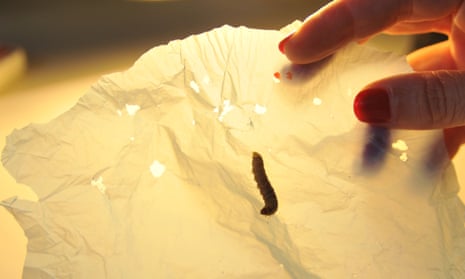For caterpillars that are bred as premium fish bait, it must rank as a better life. Rather than dangling on the end of a hook and wondering what comes next, the grubs are set to join the war on plastic waste.
The larvae of wax moths are sold as delicious snacks for chub, carp and catfish, but in the wild the worms live on beeswax, making them the scourge of beekeepers across Europe.
But in a chance discovery, a scientist and amateur beekeeper has found that waxworms have a taste for more than wax. When Federica Bertocchini removed an infestation from one of her hives and put them in a plastic bag, the worms simply ate their way out.
“I went back to the room where I had left the worms and I found that they were everywhere,” she said. “The bag was full of holes.”
The breakout led Bertocchini, a researcher at the Spanish National Research Council, and scientists at Cambridge University, to investigate the feeding habits of the centimetre-long Galleria mellonella grubs. In lab tests, they discovered that 100 worms can devour 92 milligrams of polyethylene in as little as 12 hours.
With such a voracious appetite for plastic, the worms could be put to good use, the scientists reasoned. Each year, the average person uses more than 200 plastic bags which can take between 100 and 400 years to degrade in landfill sites.
The grubs appear to breakdown polyethylene with the same enzymes they use for eating beeswax. To confirm that the worms were not simply chewing the plastic into smaller pieces, the scientists mashed some of them up and smeared the grub paste on plastic bags. Again, according to the study in Current Biology, holes appeared.
Paolo Bombelli, a biochemist at Cambridge who took part in the study, said the finding could lead to a solution to the plastic waste mounting up in waterways, oceans and landfills. With further research, the scientists hope to identify the enzymes that the waxworms produce when they go to work on a bag. The genes for these might then be put into bacteria, such as E coli, or into marine organisms called phytoplankton, and used to degrade plastics in the wild.
“We should be very happy that we have plastic for millions of items, but we need to be careful about plastic waste, and what we are studying might help for minimising that,” Bombelli said.
Because there are strict regulations around the release of genetically modified organisms into the environment, another way to reduce plastic waste could be to breed large numbers of the waxworms and let them loose on waste. But that might only be viable if the worms have an endless appetite for plastic shopping bags.
“We want to know if they’re munching the plastic to use as a food, or just because they want to escape,” said Bombelli. “If they just want to escape, they are going to get fed up very soon. But if they’re munching it to use as an energy source it’s a completely different ball game. We are not yet able to answer this, but we’re working on it.”

Comments (…)
Sign in or create your Guardian account to join the discussion